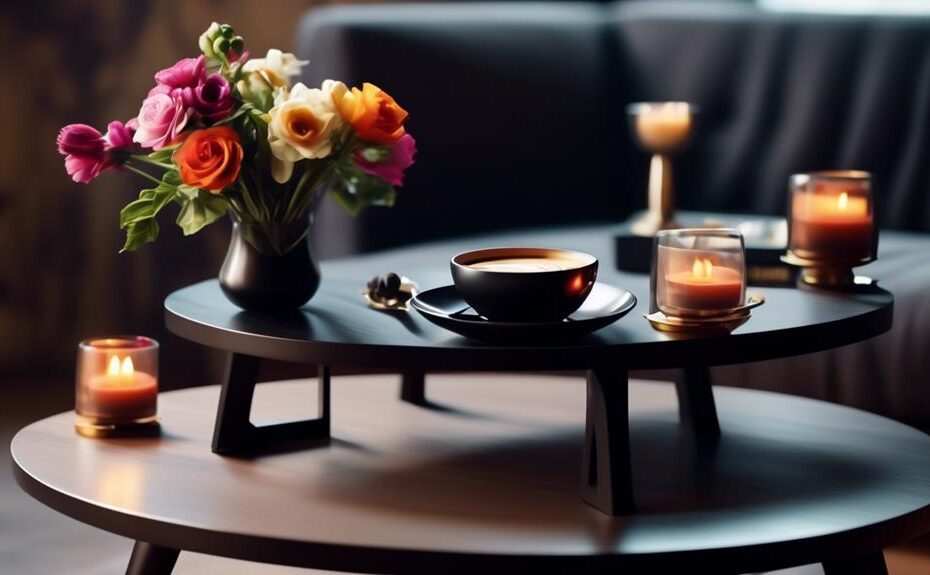In a world where functionality meets style, the coffee table stands as a centerpiece in many living spaces. Whether you're a seasoned DIY enthusiast or a beginner looking to embark on a new project, furniture plans for a coffee table can be a rewarding endeavor.
With the right tools, materials, and step-by-step instructions, you can create a customized piece that perfectly complements your home decor. From choosing the right wood to adding personalized touches, this discussion will guide you through the process of building your own coffee table.
So, why settle for a mass-produced piece when you can craft a unique and timeless statement that reflects your personal taste? Stay tuned to discover the secrets behind creating a coffee table that will elevate your living space.
Key Takeaways
- The tools and materials needed for building a coffee table include a miter saw or circular saw, drill with various bits, sander, clamps, high-quality wood, screws, wood glue, and finish or stain.
- The step-by-step instructions include measuring and marking the dimensions of each wood piece, cutting the wood pieces according to the marked dimensions, exploring alternative construction methods like dowels or pocket screws, and ensuring safety equipment and techniques are used.
- Tips for customization include considering custom engravings on the tabletop or legs, experimenting with stain or paint colors, incorporating drawers or shelves for additional storage, and adding decorative accents like metal or wooden accents.
- The finishing touches involve applying decorative accents to the legs or edges of the table, selecting color options that determine the mood and style, and choosing finishing touches that bring the table to life.
Tools and Materials Needed
To successfully build a coffee table, it is essential to have the necessary tools and materials at hand. When it comes to tools, there are a few recommendations that can make your woodworking experience more efficient.
Firstly, a miter saw or circular saw will be useful for cutting the wood to the desired lengths. A drill with various drill bits is necessary for making holes and attaching screws. A sander, whether it be a random orbital sander or a sanding block, is crucial for smoothing out the surfaces. Additionally, clamps are essential for holding the pieces together during assembly.
In terms of materials, it is important to source high-quality wood, such as oak or maple, for the table's top and legs. Other materials needed include screws, wood glue, and a finish or stain for the final touch.
Step-by-Step Instructions
The first step in building a coffee table is to carefully measure and mark the dimensions of each piece of wood. This ensures accuracy and precision in the construction process.
Once the measurements are marked, it is important to gather all the necessary tools and materials, as discussed in the previous subtopic.
With the design inspirations in mind, the next step is to cut the wood pieces according to the marked dimensions. It is essential to use proper safety equipment and techniques while cutting the wood.
After cutting the pieces, alternative construction methods can be explored, such as joining the pieces with dowels or using pocket screws for a more seamless look. These alternative methods offer different levels of stability and aesthetics, allowing for customization based on personal preferences.
Tips for Customization

After carefully measuring and cutting the wood pieces for the coffee table, it is time to explore various tips for customization. Here are three ideas to personalize your coffee table and make it truly unique:
- Custom Engravings: Consider adding custom engravings to the tabletop or legs of the coffee table. This could be your family name, a special quote, or a meaningful symbol. Engravings can add a touch of elegance and personalization to your furniture.
- Stain or Paint: Experiment with different stain or paint colors to match your existing décor or create a standout piece. Whether you prefer a rustic, natural wood look or a bold, vibrant color, the choice is yours. Staining or painting your coffee table can completely transform its appearance.
- Additional Storage: If you need extra storage space, incorporate drawers or shelves into your coffee table design. This will not only enhance its functionality but also provide a place to store remote controls, magazines, or other small items.
Finishing Touches
Enhance the overall appearance and durability of your coffee table by carefully applying the finishing touches. The decorative accents and color options you choose will have a significant impact on the final look of your furniture piece. Consider incorporating elements such as metal or wooden decorative accents to add a touch of elegance or uniqueness to your coffee table. These accents can be strategically placed on the legs or edges of the table to create visual interest. Additionally, the color options you select will determine the mood and style of the piece. Whether you opt for a natural wood finish, a bold statement color, or a classic stain, make sure it complements your existing décor and personal taste. Remember that the finishing touches are what truly bring your coffee table to life, so take your time and choose wisely.
| Decorative Accents | Color Options |
|---|---|
| Metal accents | Natural wood finish |
| Wooden accents | Bold statement color |
| Classic stain |
Maintenance and Care Tips

To ensure the longevity and pristine condition of your coffee table, proper maintenance and care are essential. Here are three important tips to keep your coffee table looking its best:
- Regular cleaning: Dust and dirt can accumulate on the surface of your coffee table, so it's important to clean it regularly. Use a soft cloth or microfiber cloth to gently wipe away any debris. Avoid using harsh chemicals or abrasive cleaners, as they can damage the finish of your table.
- Protective measures: To prevent scratches and damage, it's a good idea to use coasters for drinks and mats or trivets for hot items. This will help protect the surface from heat and moisture.
- Avoid direct sunlight: Prolonged exposure to direct sunlight can cause your coffee table's finish to fade or discolor. To prevent this, place your table away from windows or use curtains or blinds to block out the sunlight.
Frequently Asked Questions
How Long Does It Typically Take to Build a Coffee Table Using These Furniture Plans?
Typically, the time it takes to build a coffee table using furniture plans can vary depending on factors such as skill level, available tools, and the complexity of the design. However, by following tips and guidelines for choosing the right wood and designing your own coffee table, one can ensure a smooth and efficient construction process.
Can I Use Different Types of Wood for This Coffee Table Design?
Using different types of wood for a coffee table design offers a range of aesthetic and practical options. Each wood has its own unique characteristics, such as durability, grain pattern, and color, which should be considered when choosing the right material for your coffee table.
Are There Any Specific Tools or Materials That Are Recommended but Not Listed in the Article?
Additional tools and recommended materials are often necessary for completing a project successfully. It is important to consult the article or seek professional advice for a comprehensive list of required tools and materials for the coffee table design.
Can This Coffee Table Design Be Modified to Include Additional Storage Space?
Modifications for storage space can be made to the coffee table design, allowing for creative storage solutions. By incorporating additional compartments or drawers, the table can serve both as a functional piece of furniture and a space-saving storage solution.
Are There Any Safety Precautions or Recommendations to Keep in Mind While Building This Coffee Table?
When building a coffee table, it is important to prioritize safety. Some recommended safety precautions include wearing protective gear, using proper tools, and following construction guidelines. Additionally, using high-quality materials and sturdy construction techniques is advised.
Conclusion:Furniture Plans Coffee Table
In conclusion, constructing a coffee table using furniture plans requires attention to detail, precision, and functional skills. By following the step-by-step instructions and using the necessary tools and materials, one can create a customized coffee table that fits their needs and style.
Remember the adage, ‘Measure twice, cut once,' to ensure accuracy and minimize mistakes. With proper maintenance and care, this coffee table will provide a functional and stylish addition to any living space.




